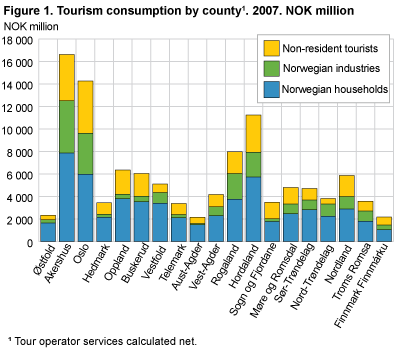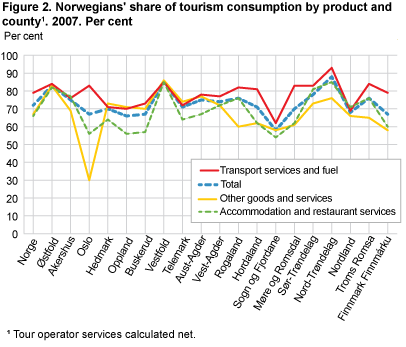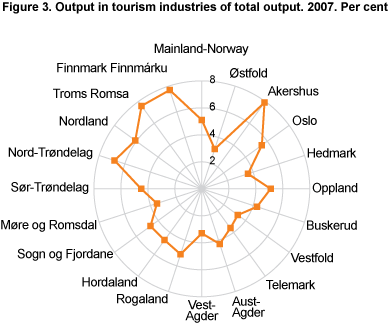Regional tourism satellite accounts
Capital has most tourism
Published:
Tourists spend more than NOK 110 billion in Norway. Almost NOK 3 out of every NOK 10 is spent in the capital city of Oslo and the neighbouring county Akershus.
According to regional tourism satellite accounts for 2007, there are variations from county to county in terms of scope and impact of tourism consumption as well as production, employment and value added in the tourism industries. Akershus and Oslo have the most tourism in absolute figures, whereas in Finnmark, which is the northernmost county and one of the counties with the lowest tourism production and consumption, tourism is one of the large industries within the county. Østfold is the county where tourism contributes the least towards value added within a county.
|
A visitor is a traveller taking a trip to a main destination outside his/her usual environment, for less than a year, for any main purpose (business, leisure or other personal purpose) other than to be employed by a resident entity in the country or place visited. A visitor is classified as a tourist if his/her trip includes an overnight stay, or as a same-day visitor otherwise. |
|
Tourism consumption in Norway is defined here as resident and non-resident tourists’ total tourism-related expenditures in Mainland Norway. This includes goods and services that are purchased by tourists, regardless of the purpose of the tourist trip. |
Norwegian tourists spend the most money
In all counties it was Norwegian tourists, including business travellers, that had the highest tourism consumption in 2007. NOK 3 out of every NOK 4 was spent by Norwegian tourists. Their leisure trips constituted three quarters of this, and subsequently half of the total tourism consumption.
Rogaland, Oslo and Akershus were the highest recipients of the Norwegian business travellers’ tourism consumption. The business travellers’ shares of the Norwegians’ tourism consumption in the respective counties were above 25 per cent in each of them. In Rogaland, the Norwegian business travellers spent more than the foreign tourists. Aust-Agder and Oppland clearly received the most from households, with shares above 90 per cent of the Norwegians’ tourism consumption.
Foreign tourists have the largest share of tourism consumption in Sogn og Fjordane
The foreign, or non-resident, tourists’ importance compared with the Norwegians varied among the counties, with shares between approximately 10 and 40 per cent. Sogn og Fjordane was the county where the foreign tourists had the highest tourism consumption in relative terms, whereas Nord-Trøndelag was the county where the foreigners constituted the lowest share of total tourism consumption.
What are tourists spending money on?
Tourism consumption is divided into three groups of goods and services. The consumption of accommodation and restaurant services is the smallest group and is estimated to be NOK 27 billion in 2007. This was rather evenly distributed among Norwegian households, Norwegian industries and foreign tourists. On the other hand, the distribution among the counties varied significantly.
The tourism consumption of other goods and services was above NOK 33 billion in 2007. Other goods and services include inter alia groceries, clothes, souvenirs and dwelling services related to own and rented holiday homes.
At country level, Norwegian leisure tourists accounted for two thirds of the consumption of other goods and services. Oslo was the county where Norwegians accounted for the lowest share; 30 per cent. Their share was highest in Vestfold, where Norwegians accounted for 85 per cent of the tourism consumption of other goods and services.
The absolutely highest item of expenditure for tourists in Norway is transport. Almost half of the tourism consumption was spent on goods and services in this product group. Transport expenditures cover expenditures on passenger transport, travel agencies, road toll, fuel etc.
The consumption of transport services was clearly highest in Oslo and Akershus. Included in this item is also transport to and from abroad, and almost half of the Norwegian tourist transport expenditure in Norway was spent on this.
How large are the tourism industries?
The output in the tourism industries constituted 5.1 per cent of total output in Mainland Norway in 2007. Again Akershus is a county that stands out with a share of 7.9 per cent, whereas Rogaland and Hordaland in this context ended below the average. All the northern counties had high shares above 6 per cent. In other words, the tourism industries have a notable impact on the total output in these counties. The tourism industries had the lowest impact in Østfold in relative terms.
An alternative method for measuring the scope of an industry is to measure the number of employees. An employee is a person who is employed by a company or working for his or her own company in domestic production activity regardless of the job being part or full time.
In 2007, 165 000 people were employed in the tourism industries. Of these, 35 000 worked in Oslo. Oslo is the county with the second highest share of employed people in the tourism industries, with 7.4 per cent of all employees. The highest share was in Nordland where 9 000 people were employed in the tourism industries in 2007, constituting 8.3 per cent of total employment in the county.
In three counties; Akershus, Nord-Trøndelag and Troms, the share of employees was lower than the share of output. For the other counties the share of employees was higher. The largest difference was in Vest-Agder where the share of the total output was 3.3 per cent, whereas the share of total employment was 6.1 per cent.
|
Tourism is a demand-side phenomenon that is best analysed with consumption expenditure figures. This is due to the tourism consumption comprising of a range of goods and services that are imported or produced and/or sold in Norway. The imported products are not included in the distribution of output.
Furthermore, the tourists consume goods and services that a wide range of industries produce, to varying extents. In most cases there are also other users of these products in addition to tourists.
Some industries are more relevant than others in this context. One can therefore choose to use their output figures when analysing tourism. These industries are defined as tourism industries. This particularly applies to industries producing services that are produced, delivered and consumed at the same place at the same time. Such industries include inter alia hotels, restaurants and passenger transport providers. |
|
The national tourism satellite accounts are published on a regular basis. This publication includes regional figures on output, value added and employment in the tourism industries for some reference years, see tables 6-8 here. Tourism consumption by regions has only been published once before ( Norwegian only ).
The tourism consumption on country level is, however, not the sum of the regionally allocated consumption. This is mainly due to tour operator services being calculated net and that Norwegian households’ consumption of groceries and other everyday goods and services used during the trip is included in the regional tourism satellite accounts. In the national tourism satellite accounts, such products are assumed to be consumed regardless of the person being on a trip or not, and consequently excluded from tourism consumption. |
Tables:
- Table 1 Regional total tourism consumption in Norway by product. 2007. NOK million
- Table 2 Regional tourism consumption in Norway by resident households by product. 2007. NOK million
- Table 3 Regional tourism consumption in Norway by resident industries by product. 2007. NOK million
- Table 4 Regional tourism consumption in Norway by non-residents by product. 2007. NOK million
- Table 5 Regional total tourism consumption in Norway by consumer. 2007. NOK million
- Table 6 Regional output in tourism industries at basic prices. 2007. NOK million
- Table 7 Employed persons by region. 2007. Number of people in 1 000
- Table 8 Value added in tourism industries by region at basic prices. 2007. NOK million
Contact
-
Statistics Norway's Information Centre



